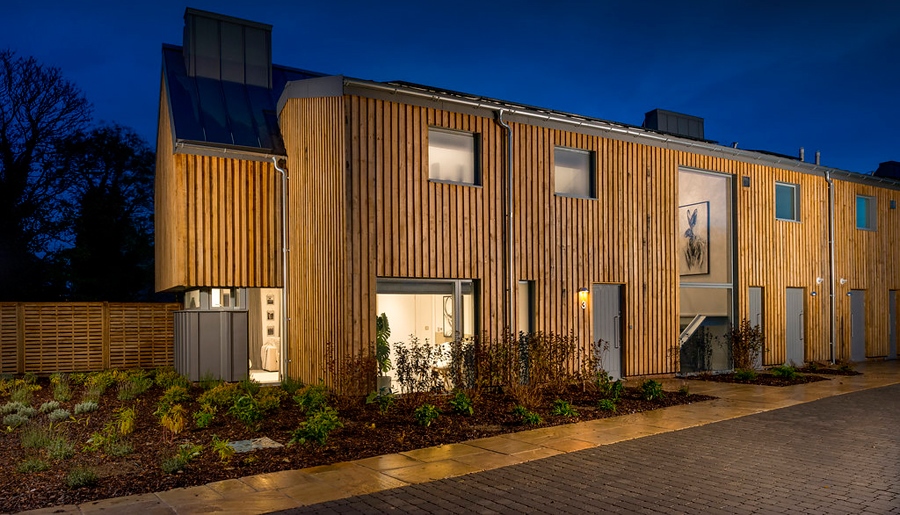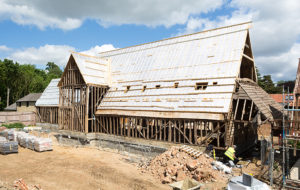David Miller Architects (DMA) has recently completed the renovation and reuse of a group of abandoned, historic barns in the countryside between Grantchester and Trumpington near Cambridge, England.
The barns date from the 17th and 18th centuries, and their £7.66 million refurbishment for client Hill Residential has repurposed them eight luxury homes, along with an additional four new homes on the site. It’s a comparatively small group of buildings; some have complex, timber-framed structures, two of which are listed historic structures. They are are one-offs, irregular and in some cases quite dilapidated.
They have now been carefully designed and restored to blend seamlessly in their original environment, and stay true to their ancient Saxon structures and Grade II historic listings.
This would normally be considered a high-risk project, given the heritage value and deteriorated structural condition. But the DMA team developed a collaborative, coordinated strategy to demonstrate that a fully digitized process is viable, achievable and beneficial on such a project, reducing risk, waste, costs, and time.
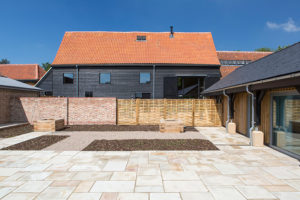 Point cloud laser technology was used to scan existing buildings, and the Building Information Modeling (BIM) model produced from it was used to greatly reduce costs.
Point cloud laser technology was used to scan existing buildings, and the Building Information Modeling (BIM) model produced from it was used to greatly reduce costs.
For instance, BIM allowed Bill-of Quantities (“specifications”, in the U.S.) and procurement information to be generated digitally without the need for an external quantity surveyor (“specifier”). This meant that full project purchasing plans could allow for detailed and timely ordering of goods and services, review of costs and avoid late orders and waste. It’s estimated that by utilizing this method, the project saved around £50,000 in setting-out groundworks alone.
Mike Beckett, Director at Hill Bespoke commented: “Having gone some way to prove that the technology is wholly beneficial on this complex refurbishment project, we have now developed processes for production and delivery of all our future housing schemes.”
BIM is a process involving the generation and management of digital representations of physical and functional characteristics of places. Setting out is also done digitally, further reducing the cost by reducing or eliminating site engineering work.
The project is somewhat remarkable because its a relatively small project for the use of such technology, and because it involves the restoration of complex and dilapidated Grade II-listed barns.
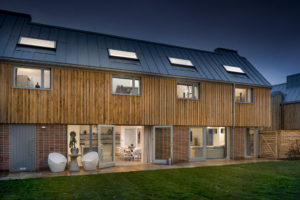 Adhering to Historic England’s principals, DMA set out to respect the previous form of the structures using original architectural materials and details such as green oak and lime bonded brickwork.
Adhering to Historic England’s principals, DMA set out to respect the previous form of the structures using original architectural materials and details such as green oak and lime bonded brickwork.
The internal character has been preserved wherever possible, with some of the barns expressing their original beams and others including exposed brickwork. Adroit procurement of using local resources and reclaimed historic materials, has allowed the new builds to compliment the conversion parts of the project.
The four new-build homes have been situated around a newly created courtyard, sitting comfortably amongst the barn conversions to create a collection of homes like no other.
The conservation of this previously abandoned site, in this beautiful part of the Cambridge countryside, has enhanced the local area which already hosts a number of historically significant buildings. This project has proven that making use of advanced digital design and construction techniques can make sense of what was an extremely complex fusion of old and new, with an end result that makes this development a gem amongst other historical luxury properties.
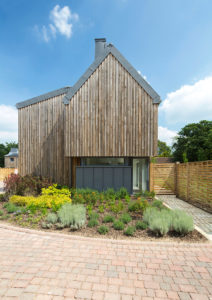 As Lauren Westpfel, a designer at DMA, explained, “Modelling the complex buildings in 3D allowed us to accurately evaluate and plan the build using as much of the original structure as possible. This gave us accurate building cost forecasts and so greatly reduced the risk.”
As Lauren Westpfel, a designer at DMA, explained, “Modelling the complex buildings in 3D allowed us to accurately evaluate and plan the build using as much of the original structure as possible. This gave us accurate building cost forecasts and so greatly reduced the risk.”
Employing high-tech digital capture methods from the outset, DMA generated 3D surveys, which in-turn aided in creating the project model. To further enhance the saleability of the barns, furniture layouts and marketing images have been produced via this programme enabling Hill to successfully promote sales off-plan.
Working on 12 buildings within a confined site, Hill Bespoke were keen to identify at the start digital strategies that could simplify the build and reduce the amount of work on an already busy site. Having used Cross Laminated Timber (CLT) on their award winning Mayfield School, DMA proposed this method to speed up the time to create new floors and walls within the conversions. Using the digital model of the existing building, the CLT was cut off-site to fit exactly into the uneven structure and simply craned into place within a matter of a few days.
On August 18, 2017, it was announced that DMA’s Anstey Hall Barns project had been shortlisted by the Royal Institution of Chartered Surveyors (RICS) for an BIM4SME Award in the “Best Use of BIM for Sustainability” category as well as “Best Overall Project”.
These awards recognize and promote achievements and adoption of BIM in projects, showcasing excellence, promoting best practice and highlighting the tremendous opportunities BIM presents to small and medium businesses.
All photos courtesy of DMA / Hill Residential.

